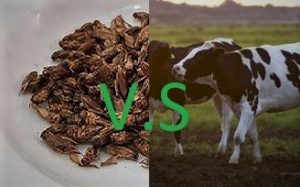BLOG
The breeding of edible insects compared to the production of meat
The breeding of edible insects: 10 times cheaper than the production of meat
On a global scale, meat production is no longer able to keep pace with steadily rising demand. Therefore, insect farming sounds like a solution to this problem. In addition, edible insect production remains 10 times cheaper than meat production. In addition, insects seem more nutritious. Thus, many organizations promote insect consumption worldwide.
The breeding of edible insects compared to the production of meat
The food
From a budgetary point of view, raising edible insects requires less food than cattle, pigs or poultry. The production of a kilo of insects requires only 2 kilos of food. However, producing one kilo of beef requires 8 kg of food. Insects also have a faster growth rate than other livestock. In addition, the loss per animal remains smaller in insect farming than in conventional breeding. 80% of the insects are actually edible and marketable against only 55% of the poultry and 40% of the cattle. In addition, obtaining 1 kg of protein in cattle farming requires 20 kg of plants, 7 kg in pig farming and only 2 kg in the edible insect farm.
The emission of greenhouse gases
The environmental impact of insect farming is one of the major assets of entomophagy. Unlike pork, poultry and cattle, edible insect production generates 100 times less greenhouse gases, but provides the same amount of protein. Indeed, pigs emit 10 to 100 times more toxic gas than insects. In addition, cockroaches, termites, beetles and a wide variety of insects lack a digestive system. Therefore, these little animals do not produce methane.
Waste reduction
Raising insects is an effective way to reduce waste. Small animals can be raised with organic by-products. In other words, cultivating land to feed them seems useless. Moreover, these critters find food to feed in manure, manure and other waste from the agri-food industry. Also, their type of food decreases the amount of waste produced.
The breeding space
Due to their size, organic insects occupy less space compared to conventional breeding. Moreover, cattle farming requires 50 to 200 m2 of space to produce 1 kg of protein. However, insect farming requires 5 to 15 m² to produce the same amount of protein. In addition, the critters consume only a tiny amount of water and draw their need for water in their food. Nevertheless, conventional agriculture consumes 70% of water from groundwater, lakes and streams.
The multiplication
A smaller space and a small size imply a minimum of maintenance. In addition, organic insects become adults in just two months and lay approximately 1,200 eggs every month. In contrast, cattle reach adulthood after two years and require nine months of gestation before generating new generations.
Energy intake and nutritional value of insects and meat
Fat and cholesterol
Insects remain the best sources of vitamins, omega 3 and 6 as well as minerals. In addition, these small animals have low fat and cholesterol levels. Indeed, traditional meat contains 48% fat on average. In contrast, insects contain only 16% fat on average. Moreover, athletes are gradually moving towards entomophagy to tap their need for protein.
Carbohydrate intake
Insects are also sources of carbohydrates, unlike traditional meat. In other words, entomophagy is the energy that is essential for the proper functioning of the body. In addition, an insect contains 17 to 18 g of carbohydrate. However, most insects contain a low carbohydrate value. Moreover, chitin fiber is the carbohydrates found in critters. It is a structural carbohydrate and not a carbohydrate reserve.
Protein intake
Insects are an excellent source of protein. Indeed, these critters contain more protein than conventional meats. Thus, eating 5 locusts is equivalent to getting the protein intake of a whole beef steak. In fact, a locust is 72% protein, but whole beef is only 52% protein. Also, insects provide 9 times more protein compared to beef. In addition, it contains on average 6 mg of iron per 100 g of dry weight. However, a grasshopper contains 8 to 20 mg iron per 100 g dry weight.
Entomophagy in the world
Insects replace meat
Researchers are thinking of gradually including insects in the human diet. Moreover, the experts emphasize the economic advantage of adopting entomophagy. In fact, producing 1 kg of beef requires 10 kg of herbs, but this same quantity of plants produces 8 to 9 kg of insects and thus 8 to 9 times more protein production. In addition, some crops already include insects in their diet. In Brussels, all grocery stores actually market caterpillars. Asian countries are places of insect consumption. In Africa, caterpillars and termites remain the most popular insects. In Europe, mealworms, crickets and ants serve as aperitifs. However, other consumers shy away from entomophagy, but say they are ready to eat it if the insects take a less visible form. In fact, many companies have included insects in feed ingredients for aquaculture and poultry farming.
Edible insect farming encouraged by international organizations
Trends predict an increase in the population to about 9 billion people by 2050. This steady rise in demographics implies an increase in food and feed production. However, this increase is harmful to the environment. For example, the United Nations, specifically the Food and Agriculture Organization of the United Nations (FAO), encourages the consumption of insects. This international organization emphasizes the important energy intake and nutritional values present in these critters. FAO is also promoting large-scale edible insects to promote food security and fight hunger in developing countries. This organization also specifies the ecological and economic interest of such a regime. In addition, the promotion of entomophagy remains in place despite the adoption of the regime by more than 2 billion people.


 Français
Français Deutsch
Deutsch Español
Español

